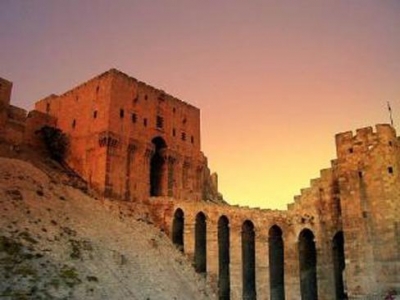Aga Khan Helps Ravaged Syrian City Aleppo Regain Ancient Glory - 2010-04-16
April 16 (Bloomberg) -- It’s hard to know which of history’s episodes was worse for Aleppo, an ancient fortress city in Syria’s north. Perhaps it was in the year 1400, when Tamerlane, the invading Mongol-Turkic chieftain, piled thousands of skulls at the town gates to persuade inhabitants to give up.
Or maybe the earthquake of 1136 that killed tens of thousands of inhabitants, or the massacre of Muslims by more Mongol invaders in 1260 or the 19th-century assaults by cholera and plague.
Aleppo unsuccessfully tried to keep out invading Hittites, Assyrians, Arabs, Mamelukes and Ottomans with giant moats and stone walls two meters (6 feet) thick. Still, residents proudly note that it is one of the world’s oldest continuously inhabited settlements. Now Aleppo -- with its brooding medieval castle, orange trees and secluded courtyards -- is facing the challenge of welcoming foreign visitors.
“Aleppo is moving out of the shadows,” said Mahmoud Ramadan, an engineer and member of the municipality’s City Development Strategy for urban renewal through 2025. “We’ve been mostly left by the wayside. We look forward to the day when Aleppo will again be a gate to the outside world.” The city was a western terminus of the Silk Road from China until the 19th-century construction of the Suez Canal undermined its importance in East-West trade.
For its latest comeback, an ambitious restoration project is near completion in the Old City. A master plan for development has been laid out for the next 15 years.
Moat Rubble
The most spectacular renewal is the Citadel castle: Workers cleared its deep moat, cleaned its formidable walls and removed tons of rubble. The work is backed by the Aga Khan Trust for Culture, which aims to revitalize rundown communities and monuments.
The surrounding warren of alleys and lanes is a hodgepodge of stone buildings, mosques and churches, caravanserais and hammams. Here, waterworks and electrical lines have been fixed and streets repaved.
Homeowners were given loans to help renovate their houses and have a stake in the district’s gentrification.
“We want this to be a living city. It would be a disaster if the current residents left,” Adli Qudsi, an architect who has campaigned to save old Aleppo for 32 years, said in an interview.
Aleppo has what might be called second-city blues. Like St. Petersburg, Aleppo was once a capital in its own right. With Syria’s independence in 1946, Aleppo became a provincial outpost and was eclipsed by Damascus, the national capital. Decades of uneasy Syrian relations with nearby Turkey made it a cul-de-sac.
Axis of Evil
Now, Syria appears to be opening up for investment, trade and tourism and Aleppo hopes to benefit. Easing relations with the U.S. may alleviate Syria’s reputation in the West as an Axis of Evil adjunct -- though the country remains on the State Departmentlist of terror sponsors. New visa-free travel to and from Turkey has made the city a way stop.
“We have been receding and we feel a little mistreated by the focus on Damascus,” said Qudsi. “But we’re coming back.”
In 1978, Qudsi led a drive by a small group of Aleppians to restore the 350 hectare (865 acres) Old City. From the 1950s through the 1970s old neighborhoods had been bulldozed to make way for boulevards. New city services were provided to modern suburbs and the Old City decayed.
World Heritage
In 1986, the United Nations Educational, Scientific and Cultural Organization put Aleppo onto its list of World Heritage sites, a designation meant to encourage governments to preserve historical and natural locales. In 1994, Deutsche Gesellschaft Fuer Technische Zusammenarbeit (GTZ), a private agency that supports the German government’s international development projects, joined Aleppo’s municipal authorities in water and sanitation projects and provided loans of up to $3,000 that helped fix about 700 houses. Before replacement, pipes in the old town dated from the 12th century.
The area houses about 125,000 residents out of a total city population of 1.7 million. Qudsi grew up among the narrow alleys and mazes that lead to dead ends. They were a form of privacy for residents who sometimes put doors across the lanes to keep unwanted visitors out.
“I was born in 1940, but it might as well have been 1740,” Qudsi said. Zoning rules will keep hotels and restaurants confined to specific areas, to avoid old Aleppo becoming a kind of Oriental Disneyland, he said: “It would be a disaster for residents to leave.”
The Mansouriya Palace boutique hotel, a combination of two houses set around a courtyard decorated by a rectangular pool and an orange tree, provides a glimpse of the elegant possibilities of old Aleppo for tourism. Qudsi said. Its nine rooms are done in styles reflecting parts of Aleppo’s history, among them Greco-Roman, Byzantine, Ottoman and Hittite.
There is, by the way, no Tamerlane suite.
To contact the reporter on the story: Daniel Williams in Aleppo at dwilliams41@bloomberg.net.
Last Updated: April 15, 2010 19:01 EDT
- 19414 reads
 Ismaili.NET - Heritage F.I.E.L.D.
Ismaili.NET - Heritage F.I.E.L.D.